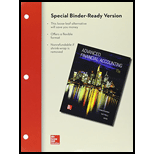
Concept explainers
Sale of subsidiary common shares: When a parent sells subsidiary shares, a gain or loss normally occurs and is recorded on the seller’s books, which needed to be recognized in consolidated net income. Under ASE 810, changes in a parent’s ownership interest in a subsidiary while the parent retains control require an adjustment to the amount assigned to the non-controlling interest to reflect its change in ownership in the subsidiary. Any difference in fair value of the controlling interest results in an adjustment to the
A memo to present alternative ways to record the difference between the carrying value and sales price of the share that are sold and recommend preferred reporting alternative.
Want to see the full answer?
Check out a sample textbook solution
Chapter 9 Solutions
LOOSE-LEAF Advanced Financial Accounting with Connect
 Cornerstones of Financial AccountingAccountingISBN:9781337690881Author:Jay Rich, Jeff JonesPublisher:Cengage Learning
Cornerstones of Financial AccountingAccountingISBN:9781337690881Author:Jay Rich, Jeff JonesPublisher:Cengage Learning Intermediate Accounting: Reporting And AnalysisAccountingISBN:9781337788281Author:James M. Wahlen, Jefferson P. Jones, Donald PagachPublisher:Cengage Learning
Intermediate Accounting: Reporting And AnalysisAccountingISBN:9781337788281Author:James M. Wahlen, Jefferson P. Jones, Donald PagachPublisher:Cengage Learning



